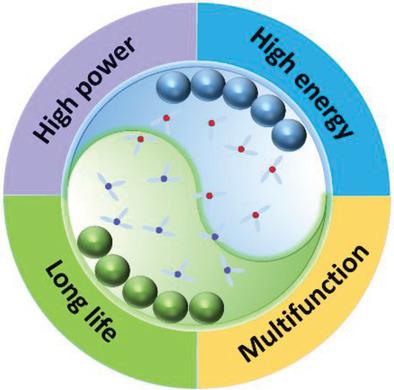当前位置:
X-MOL 学术
›
Adv. Funct. Mater.
›
论文详情
Our official English website, www.x-mol.net, welcomes your feedback! (Note: you will need to create a separate account there.)
Rational Design of Nanostructured Electrode Materials toward Multifunctional Supercapacitors
Advanced Functional Materials ( IF 19.0 ) Pub Date : 2019-07-24 , DOI: 10.1002/adfm.201902564 Jian Yan 1, 2 , Shaohui Li 3 , Binbin Lan 1, 2 , Yucheng Wu 1, 2 , Pooi See Lee 3
Advanced Functional Materials ( IF 19.0 ) Pub Date : 2019-07-24 , DOI: 10.1002/adfm.201902564 Jian Yan 1, 2 , Shaohui Li 3 , Binbin Lan 1, 2 , Yucheng Wu 1, 2 , Pooi See Lee 3
Affiliation

|
As an intermediate step during energy usage, supercapacitors with superior power density, long‐term cycling stability, and moderate energy density have attracted immense interest as a facile route to use energy in a clean, efficient, and versatile manner in smart grid applications, as well as portable devices and other applications. Currently, the major drawback of supercapacitors is the low energy density. Electrode materials are the key components determining the cell performance. Great research efforts are made to develop nanostructured electrode materials with high performance. On the other hand, integrating supercapacitors with other applications have led to the emergence of many new types of multifunctional supercapacitors, which are attractive for a myriad of applications. The current understanding on charge/discharge mechanisms of electric double layer capacitors and pseudo‐capacitors is discussed along with recent development in designing nanostructured electrode materials by structure/morphology engineering, doping, and crystal structure controlling. Achievements in multifunctional supercapacitors like flexible supercapacitors, all‐solid‐state supercapacitors, self‐healing supercapacitors, electrochromic supercapacitors, self‐chargeable supercapacitors, and supercapacitors integrated with sensors are illustrated. Finally, opportunities and challenges in developing high performance and multifunctional supercapacitors are proposed.
中文翻译:

面向多功能超级电容器的纳米结构电极材料的合理设计
作为能源使用过程中的一个中间步骤,具有超高功率密度,长期循环稳定性和中等能量密度的超级电容器作为一种在智能电网应用中以清洁,高效,通用的方式使用能源的便捷途径,引起了人们的极大兴趣。以及便携式设备和其他应用程序。当前,超级电容器的主要缺点是能量密度低。电极材料是决定电池性能的关键成分。为了开发高性能的纳米结构电极材料,人们付出了巨大的努力。另一方面,将超级电容器与其他应用程序集成在一起导致了许多新型的多功能超级电容器的出现,这对于众多应用程序都具有吸引力。讨论了当前对双电层电容器和伪电容器的充电/放电机理的理解,以及通过结构/形态工程,掺杂和晶体结构控制设计纳米结构电极材料的最新进展。说明了多功能超级电容器(如柔性超级电容器,全固态超级电容器,自修复超级电容器,电致变色超级电容器,自充电超级电容器以及与传感器集成在一起的超级电容器)的成就。最后,提出了开发高性能和多功能超级电容器的机遇与挑战。和晶体结构控制。说明了多功能超级电容器(如柔性超级电容器,全固态超级电容器,自修复超级电容器,电致变色超级电容器,自充电超级电容器以及与传感器集成在一起的超级电容器)的成就。最后,提出了开发高性能和多功能超级电容器的机遇与挑战。和晶体结构控制。说明了多功能超级电容器(如柔性超级电容器,全固态超级电容器,自修复超级电容器,电致变色超级电容器,自充电超级电容器以及与传感器集成在一起的超级电容器)的成就。最后,提出了开发高性能和多功能超级电容器的机遇与挑战。
更新日期:2020-01-11
中文翻译:

面向多功能超级电容器的纳米结构电极材料的合理设计
作为能源使用过程中的一个中间步骤,具有超高功率密度,长期循环稳定性和中等能量密度的超级电容器作为一种在智能电网应用中以清洁,高效,通用的方式使用能源的便捷途径,引起了人们的极大兴趣。以及便携式设备和其他应用程序。当前,超级电容器的主要缺点是能量密度低。电极材料是决定电池性能的关键成分。为了开发高性能的纳米结构电极材料,人们付出了巨大的努力。另一方面,将超级电容器与其他应用程序集成在一起导致了许多新型的多功能超级电容器的出现,这对于众多应用程序都具有吸引力。讨论了当前对双电层电容器和伪电容器的充电/放电机理的理解,以及通过结构/形态工程,掺杂和晶体结构控制设计纳米结构电极材料的最新进展。说明了多功能超级电容器(如柔性超级电容器,全固态超级电容器,自修复超级电容器,电致变色超级电容器,自充电超级电容器以及与传感器集成在一起的超级电容器)的成就。最后,提出了开发高性能和多功能超级电容器的机遇与挑战。和晶体结构控制。说明了多功能超级电容器(如柔性超级电容器,全固态超级电容器,自修复超级电容器,电致变色超级电容器,自充电超级电容器以及与传感器集成在一起的超级电容器)的成就。最后,提出了开发高性能和多功能超级电容器的机遇与挑战。和晶体结构控制。说明了多功能超级电容器(如柔性超级电容器,全固态超级电容器,自修复超级电容器,电致变色超级电容器,自充电超级电容器以及与传感器集成在一起的超级电容器)的成就。最后,提出了开发高性能和多功能超级电容器的机遇与挑战。

























 京公网安备 11010802027423号
京公网安备 11010802027423号